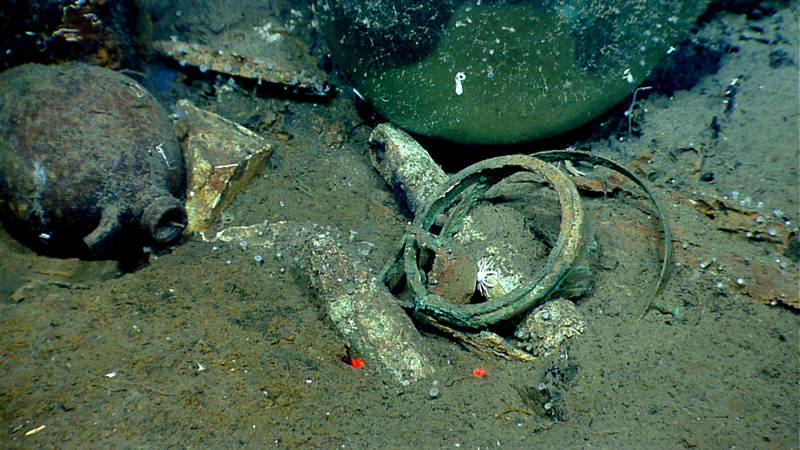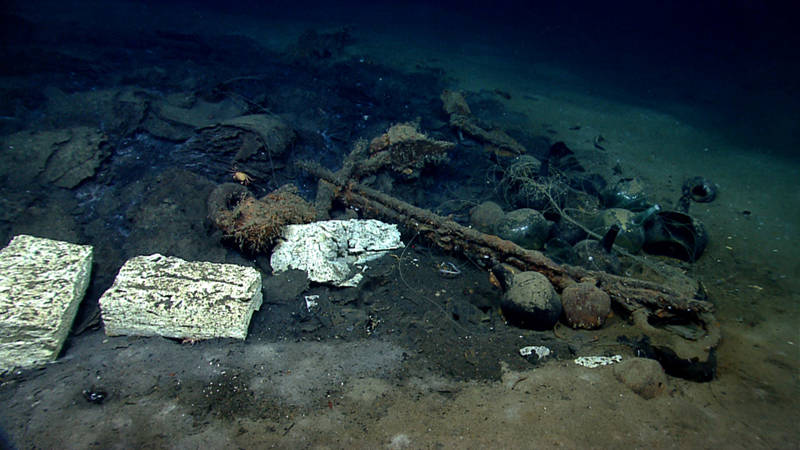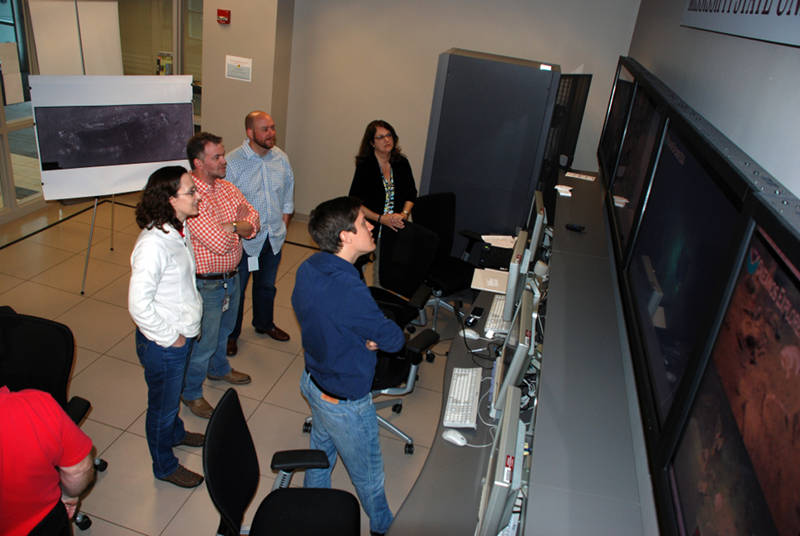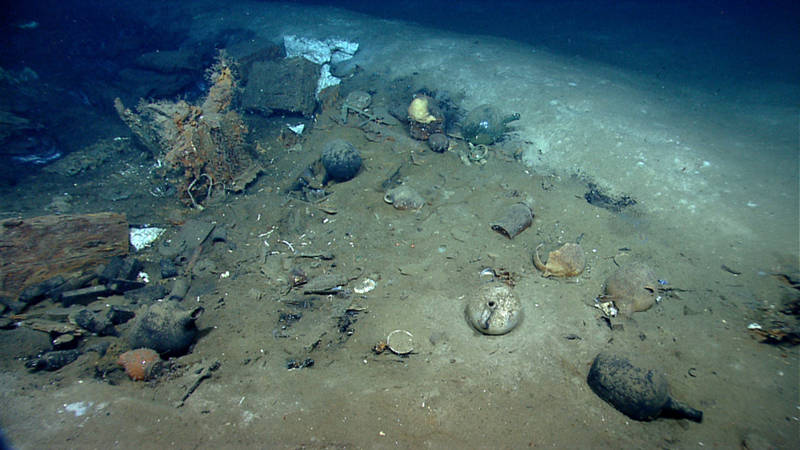
By Dr. Alicia Caporaso, Marine Archaeologist - Bureau of Ocean Energy Management
April 20, 2014

Two depth sounding leads used to measure the depth of water under the vessel and to characterize the local seafloor and a brass frame and gimbal band, likely for a compass, all nestled among glass and ceramic bottles and jugs. Image courtesy of the NOAA Office of Ocean Exploration and Research, Exploration of the Gulf of Mexico 2014. Download larger version (jpg, 1.8 MB).

The bow section of Monterrey B. Pictured here are glass demijohns, what has been tentatively identified as blocks of tallow and roles of cattle hides, and a large iron anchor. Intrusive modern fishing line is entangled on the shipwreck. Image courtesy of the NOAA Office of Ocean Exploration and Research, Exploration of the Gulf of Mexico 2014. Download larger version (jpg, 1.5 MB). Video highlights from Dive 07.
After a three-day delay due to the effects of stormy weather over the Gulf of Mexico, on Saturday April 19, 2014, the waves calmed and the water cleared, providing excellent conditions for the long-anticipated return dive to the shipwreck currently known as Monterrey B.
Discovered as a small sonar target in a high-resolution side scan sonar survey conducted for Shell Offshore in 2012, Monterrey B was first investigated in 2013 during a two-hour remotely operated vehicle (ROV) reconnaissance survey from the Exploration Vessel Nautilus. This brief investigation provided a tantalizing glimpse of a well-defined early 19th-century shipwreck chock full of fascinating cargo, personal items, and vessel hardware with a unique community of colonizing benthic animals. The Monterrey Shipwrecks Project archaeologists and biologists could hardly wait to return!

Archaeologists from the Bureau of Ocean Energy Management and University of West Florida participate from the Exploration Command Center at Stennis Space Center. Image courtesy of the NOAA Office of Ocean Exploration and Research, Exploration of the Gulf of Mexico 2014. Download larger version (jpg, 4.8 MB).
As the ROV Deep Discoverer descended the ~1,300 meters to the seafloor, the project team, participating remotely from several Exploration Command Centers around the country, excitedly discussed the planned survey of the site including up-close inspection of artifacts and organisms spotted in the video collected the previous year.
As the ROV approached the shipwreck from off the stern, the first artifacts to clearly appear where the bright white ceramics and large blocks of yellow-white material tentatively identified as tallow, or rendered beef fat, a product commonly used at this time in the production of soap and inexpensive candles. During the eight-hour dive, the ROV slowly circled the shipwreck, inspecting the construction of the vessel and individual artifacts for diagnostic features that will help date and identify the site for its type, rigging, purpose, nationality, origin and destination, and hopefully, if we are lucky, its name.
Artifacts and features of particular interest include: an iron gudgeon and pintle used to connect the rudder to the vessel; a cast iron ship's stove; two cántaros, Mexican ceramic water jars produced in the Yucatan; large glass utilitarian bottles called demijohns, which were used to transport liquor; ceramic tableware including a small blue and white bowl with a castle decoration; navigational instruments such as two octants, a compass, two depth-sounding leads, a telescope, and several sand clocks; roles and stacks of hides; and wooden boxes or crates that are unbelievably still intact and presumably encase their original contents.

The stern section of Monterrey B. Pictured here are items that would have been under the control of the vessel's officers including navigational instruments, fine ceramics, and liquor bottles. Image courtesy of the NOAA Office of Ocean Exploration and Research, Exploration of the Gulf of Mexico 2014. Download larger version (jpg, 1.6 MB).
Our current hypothesis is that Monterrey B represents a merchant vessel dating to the 1810s-1820s, carrying a cargo of hides and other cattle products and bottled spirits. Its small size, lack of copper sheathing, and inexpensive construction features indicate that it may have been built on the Gulf coast for regional use. At this time, Mexico was a center of cattle production. A popular Mexican liquor called Mezcal (distilled from a type of agave) was shipped and served in demijohns. The cargo of hides and demijohns and the cántaros hint that Mexico may have been the last port of call for Monterrey B before it wrecked.
Monterrey B’s association with the Monterrey A and C shipwrecks provides clues that it may have been under sail either as a captured prize by a pirate or privateer, or travelling through dangerous waters with a military escort when it capsized in a violent storm. The organic nature of the cargo, the materials used in the construction of the vessel, and the environment into which it sank has allowed the development of a unique community of biota including species of crab, squat lobsters, wood-boring mollusks, chemosynthetic worms, hard and soft-bodied corals, and bacteria.
The data collected in this ROV dive will be analyzed by archaeological and biological specialists, the results of which will be presented to the public through a variety of media and social fora, and be used to plan future investigation of the site.
The Monterrey Shipwrecks Project is a truly collaborative effort supported by scientists from several Federal and state agencies and institutions including: NOAA Office of Ocean Exploration and Research; NOAA National Marine Sanctuaries; the Bureau of Ocean Energy Management; the Bureau of Safety and Environmental Enforcement; the Meadows Center for Water and the Environment at Texas State University; the Texas Historical Commission; Ocean Exploration Trust; and the Graduate School of Oceanography at the University of Rhode Island.
Scientific and educational support has also been provided by Texas A&M Galveston, Maryland Historic Trust, ExploreOcean; and other archaeology and marine biology specialists around the country.